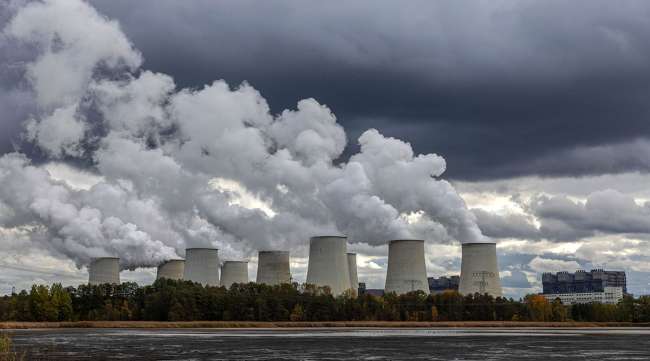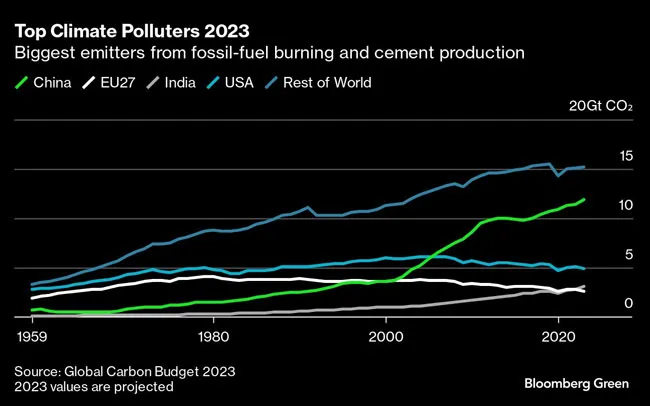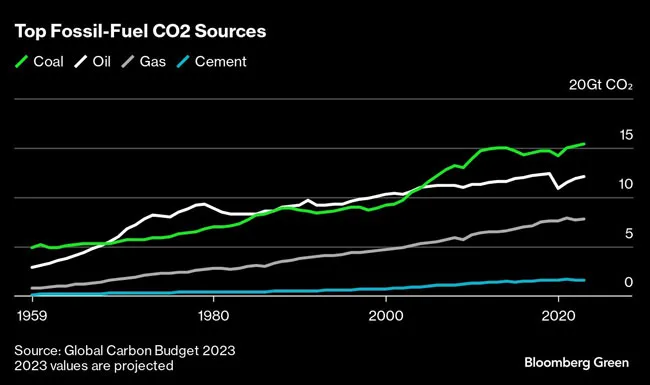Global Fossil Fuels Emissions to Hit Record Peak in 2023

[Stay on top of transportation news: Get TTNews in your inbox.]
The Global Carbon Project, an international collaboration of scientists, estimates that worldwide carbon dioxide emissions from burning fossil fuels will rise 1.1% this year over 2022, to 36.8 billion metric tons. That’s a new peak and 1.4% higher than the level in 2019, before the COVID-19 pandemic.
The planet is on track to exceed its carbon budget for 1.5C of warming around 2030, and the budget for 1.7C in 15 years, according to the group’s Global Carbon Budget annual report, released as talks continue at the COP28 climate conference in Dubai.
The 2023 estimate marks a slowdown in emissions’ upward trend, but what’s needed is a consistent drop — of roughly 9% a year, says the United Nations Environment Program — for the world to have a shot at keeping global heating below the 1.5C target in the Paris Agreement. (Emissions fell 5.4% during the pandemic in 2020 before starting to rise again.)
Fossil fuel emissions have declined in more than two dozen countries, which are collectively responsible for more than a quarter of the world’s total. But their progress wasn’t enough to contain an overall climb in 2023.

The European Union’s emissions dropped 7.4% this year on declining fossil fuel use. But India surpassed the EU as the world’s third-biggest emitter, driven by a 9.5% increase in coal, 5.6% jump in oil and 8.8% rise in cement CO2.
China remains the world’s emissions juggernaut, responsible for 31% of carbon emissions. The U.S., the largest emitter historically, trails China at 14%.
The increased fossil fuel use comes even as renewable energy has become a mature industry. “Even that rapid growth in renewables has not been sufficient by itself to push out the fossil fuels,” said Glen Peters, senior researcher at the CICERO Centre for International Climate Research in Norway and a report author. “In my mind, that just really clarifies that if you want to get the fossil fuels out, you have to have policies which get the fossil fuels out.”
Coal plant closures, fuel-switching and renewables in the U.S. led to an 18.3% decline in coal use, bringing it down to its 1903 level. The EU saw a drop of similar magnitude.

When changes to land use are included, the estimated 2023 emissions total rises to 40.9 billion tons. Deforestation is responsible for 4.2 billion tons of carbon a year for the last decade. That’s 2.2 times the amount of CO2 absorbed by new or healthier forests.
For the first time in this year’s report, the Global Carbon Project breaks out emissions related to aviation and shipping, which are up 28% and 1% year-on-year, as air transport in particular recovers from the pandemic.
After an unprecedented fire season in Canada, the scientists also offer an analysis of global wildfire emissions, which reached as high as 8 gigatons, or a third higher than the 2013-2022 average for the first 10 months of the year. That’s equivalent to about 70% of China’s emissions from burning fossil fuels.
Four of the report’s authors collaborated with other researchers on a separate study, published Dec. 4 in the journal Nature Climate Change. It challenges a critical assumption in debates over the potential role of technologies that remove some CO2 from the atmosphere.
Carbon removal has been a major subject of discussion at COP28, with some scientists saying it will be necessary to limit global heating, if not a substitute for curbing greenhouse gas emissions.
There’s not necessarily a one-to-one relationship between emitting and absorbing carbon, for four reasons, the study says.
Want more news? Listen to today's daily briefing above or go here for more info
First, there’s the problem of “permanence,” or the concern that carbon removed by plants or oceans may return to the atmosphere. Second, reforestation — while a major goal of many countries and advocates — can darken the color of land, thereby attracting more light and heat to the ground. Third, a drawdown of CO2 could have the perverse effect of increasing emissions of nitrous oxide and methane, two powerful greenhouse gases.
Finally, there’s an “asymmetry” between the carbon flow and the temperature’s response. In other words, the temperature reduction from removing carbon may be less than the heat retained when it was in the atmosphere.
The authors are right to point out the differences between removing CO2 and not emitting it to begin with, said Kate Marvel, senior climate scientist at Project Drawdown, who was not involved in the research. “If we plant a bunch of trees, or hack the ocean, to take up more carbon, we have to worry about when that carbon will be released back into the atmosphere,” she said. That’s “something we don’t have to think about if we never emit that carbon at all.”
“What goes up and what goes down are not necessarily equal,” said Peters, who is also a co-author of the Nature Climate Change paper. “Net zero is tougher than what you may think. I guess that’s one way of putting it.”




